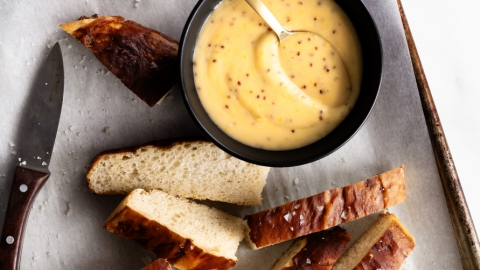Muster Up Some Flavour
When it comes to condiments, there are few that can hold a candle to mustard. Tangy, spicy and full of umami, there is nothing I’d rather slather rye bread with, dip my veggies into or dress my salads with. At any given moment, there are likely three open jars in my fridge and several in waiting for those moments when I’ve run out—but let’s be real, I’d never let that happen. Mustard is the indispensable culinary hero most people, including myself, couldn’t do without.
However, adoration for mustard is no modern phenomenon—it’s been making eyes water for millennia. Though archaeological evidence is lacking for the very first domesticated mustard species, its wild predecessors were well established in Chinese and Indian cuisine dating back 6000 years. Yet the earliest use of mustard seed dates back even further, according to Sanskrit texts. Though mustard seeds have been used widely throughout history, we likely have the Romans to thank for the very first prepared condiment. Ground mustard seed combined with unfermented grape must formed what was referred to as “mustum-ardens” or “burning must,” which was used for medicinal as well as culinary purposes. Mustard preparation was later adopted by the French, primarily in the Dijon region, and spread its way across Europe and North America thereafter. Today, mustard is one of the most popular and beloved condiments, with an international array of strengths, flavours and textures to show for it.
Intensely hot, sharp, bitter and pungent, mustard seeds create the foundation for all prepared mustard. The type and combination of seeds along with the production method gives rise to the many well-known and contemporary flavours we see today. Three varieties of cultivated seeds—yellow, brown or black—offer varying degrees of heat and can be used whole, bruised, cracked or ground to release more or less of their pungent oils. The degree of pungency is further enhanced or reduced by the type and temperature of the liquid used—ironically, hot water and acidic liquid, like vinegar, will produce a more mild mustard, with hotter varieties using little or no vinegar and colder water.
There is a mustard for almost every taste and a favourite variety for many traditional dishes. Generally speaking, hotter varieties such as English, brown, Chinese or German are excellent paired with meaty sandwiches, sausages or roasts. Dijon always make a great fit for vinaigrette or sauce and American yellow is an easy choice for burgers and dogs. A dish of whole grain mustard fits seamlessly on charcuterie boards, and honey or spirit-infused mustard is an excellent dip for veggies or crispy breaded chicken. Of course, mustard isn’t reserved solely for dipping and spreading; it makes a brilliant marinade for meat and fish and can even be used in (not just on) bread, with mustard buns being a prime example. Nevertheless, there are no hard and fast rules for mustard use—a nose-tingling hot mustard is perfectly acceptable for carrot sticks, in my opinion.
While it’s tempting to consider myself a global contender for the most mustard consumed annually, that award actually goes to the UK, Germany and France. Predictably, Europe, as a whole, is the largest consumer of prepared mustard, though production of mustard seeds sits chiefly with Nepal, Russia and Canada. Being a cool-season crop, mustard plants flourish in Canada’s northern climate, with the first commercial mustard production beginning in Alberta in the 1930s. Today, Saskatchewan is home to 75% of Canada’s mustard seed production for global export.
But it’s not just seeds: artisanal mustard producers can be found across Canada as well, with several located here on the Island: Qualicum’s Yellow Deer Mustard creates gourmet flavours like curry, dill pickle and whiskey maple, and any one of Two Crow’s beautifully handcrafted mustards would elevate your next sandwich.
Local mustard locations:
The Mustard Lady, Courtenay Yellow Deer Mustard, Qualicum Goats on the Roof Mustard, Coombs Two Crows Craft Foods, Victoria Sarah's Staples, North Saanich |






